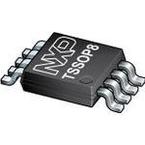Overview
●The PCA9617A is a CMOS integrated circuit that provides level shifting between low voltage (0.8 V to 5.5 V) and higher voltage (2.2 V to 5.5 V) Fast-mode Plus (Fm+) I²C-bus or SMBus applications. While retaining all the operating modes and features of the I²C-bus system during the level shifts, it also permits extension of the I²C-bus by providing bidirectional buffering for both the data (SDA) and the clock (SCL) lines, thus enabling two buses of 540 pF at 1 MHz or up to 4000 pF at lower speeds. Using the PCA9617A enables the system designer to isolate two halves of a bus for both voltage and capacitance. The SDA and SCL pins are overvoltage tolerant and are high-impedance when the PCA9617A is unpowered.
●The 2.2 V to 5.5 V bus port B drivers have the static level offset, while the adjustable voltage bus port A drivers eliminate the static offset voltage. This results in a LOW on the port B translating into a nearly 0 V LOW on the port A which accommodates the smaller voltage swings of lower voltage logic.
●The static offset design of the port B PCA9617A I/O drivers prevents them from being connected to the static or incremented offset of other bus buffers. Port A of two or more PCA9617As can be connected together, however, to allow a star topography with port A on the common bus, and port A can be connected directly to any other buffer with static or incremented offset outputs. Multiple PCA9617As can be connected in series, port A to port B, with no build-up in offset voltage with only time of flight delays to consider.
●The PCA9617A drivers are not enabled unless VCC(A) is above 0.8 V and VCC(B) is above 2.2 V. The EN pin is referenced to VCC(B) and can also be used to turn the drivers on and off under system control. Caution should be observed to only change the state of the enable pin when the bus is idle.
●The output pull-down on the port B internal buffer LOW is set for approximately 0.55 V, while the input threshold of the internal buffer is set about 90 mV lower (0.45 V). When the port B I/O is driven LOW internally, the LOW is not recognized as a LOW by the input. This prevents a latching condition from occurring. The output pull-down on port A drives a hard LOW and the input level is set at 0.35 VCC(A) to accommodate the need for a lower LOW level in systems where the low voltage side supply voltage is as low as 0.8 V.
●MoreLess
●## Features
● 2 channel, bidirectional buffer isolates capacitance and allows 540 pF on either side of the device at 1 MHz and up to 4000 pF at lower speeds
● Voltage level translation from 0.8 V to 5.5 V and from 2.2 V to 5.5 V
● Footprint and functional replacement for PCA9517A at Fast-mode speeds
● Port A operating supply voltage range of 0.8 V to 5.5 V with normal levels
● Port B operating supply voltage range of 2.2 V to 5.5 V with static offset level
● 5 V tolerant I²C-bus and enable pins
● 0 Hz to 1000 kHz clock frequency (the maximum system operating frequency may be less than 1000 kHz because of the delays added by the repeater)
● Active HIGH repeater enable input referenced to VCC(B)
● Open-drain input/outputs
● Latching free operation
● Supports arbitration and clock stretching across the repeater
● Accommodates Standard-mode, Fast-mode and Fast-mode Plus I²C-bus devices, SMBus (standard and high power mode), PMBus and multiple masters
● Powered-off high-impedance I²C-bus pins
● ESD protection exceeds 5500 V HBM per JESD22-A114 and 1000 V CDM per JESD22-C101
● Latch-up testing is done to JEDEC Standard JESD78 which exceeds 100 mA
● Packages offered: TSSOP8 and HWSON8
●## Features


